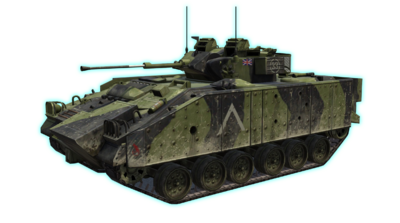Falli (Diskussion | Beiträge) (Die Seite wurde neu angelegt: „{{Infobox |image=Warrior.png |title=Warrior |bodyClass=floatright |col=1 |section1 = |label1 = Besatzung ||content1 = Kommandant, Richtschütze, Fahrer |label2 = Bedienung |content2 = <span style="color:red">'''Menschlich'''</span>, KI |label3 = Hauptbewaffnung |content3 = 30mm Rarden L21A1 Maschinenkanone (228 Schuss) |label4 = Zusatzbewaffnung |content4 = 1x 7,62mm L94A1 Koaxial-MG (2200 Schuss), Nebelmittelwurfanlage (16 Schuss), Absitzstärke: max. 7…“) |
Falli (Diskussion | Beiträge) Keine Bearbeitungszusammenfassung |
||
| Zeile 27: | Zeile 27: | ||
The Warrior tracked vehicle family is a series of British armoured vehicles, originally developed to replace FV430 series armoured vehicles. The Warrior started life as the MCV-80, "Mechanised Combat Vehicle for the 1980s". One of the requirements of the new vehicle was a top speed able to keep up with the projected new MBT, the MBT-80 – later cancelled and replaced by what became the Challenger 1 – which the FV432 armoured personnel carrier could not. The project was begun in 1972; GKN Defence won the production contract in 1984 and the Warrior was accepted for service with the British Army in November 1984. Production commenced in January 1986 at Telford, with the first vehicles completed in December that year. GKN Defence was purchased by BAE Systems, via Alvis plc. | The Warrior tracked vehicle family is a series of British armoured vehicles, originally developed to replace FV430 series armoured vehicles. The Warrior started life as the MCV-80, "Mechanised Combat Vehicle for the 1980s". One of the requirements of the new vehicle was a top speed able to keep up with the projected new MBT, the MBT-80 – later cancelled and replaced by what became the Challenger 1 – which the FV432 armoured personnel carrier could not. The project was begun in 1972; GKN Defence won the production contract in 1984 and the Warrior was accepted for service with the British Army in November 1984. Production commenced in January 1986 at Telford, with the first vehicles completed in December that year. GKN Defence was purchased by BAE Systems, via Alvis plc. | ||
The first production vehicle was handed over to the British Army in May 1987 to 1st Battalion Grenadier Guards and from 1988 to 1990 four more armoured infantry battalions in the British Army of the Rhine were converted to the new vehicle. | The first production vehicle was handed over to the British Army in May 1987 to 1st Battalion Grenadier Guards and from 1988 to 1990 four more armoured infantry battalions in the British Army of the Rhine were converted to the new vehicle. A total of 789 FV510 and variants were manufactured for the British Army and 254 of a modified version (Desert Warrior) were produced for the Kuwaiti Army. {{Quelle|url=https://en.wikipedia.org/wiki/Warrior_tracked_armoured_vehicle|title=Warrior tracked armoured vehicle|date=|access_date=30.09.2023|website=Wikipedia|author= |page=|section=|url_internal=|ref=true|ref_name=|ref_group=|archive_url=|archive_date=}} | ||
== Munition == | == Munition == | ||
Aktuelle Version vom 30. September 2023, 16:38 Uhr
The Warrior tracked vehicle family is a series of British armoured vehicles, originally developed to replace FV430 series armoured vehicles. The Warrior started life as the MCV-80, "Mechanised Combat Vehicle for the 1980s". One of the requirements of the new vehicle was a top speed able to keep up with the projected new MBT, the MBT-80 – later cancelled and replaced by what became the Challenger 1 – which the FV432 armoured personnel carrier could not. The project was begun in 1972; GKN Defence won the production contract in 1984 and the Warrior was accepted for service with the British Army in November 1984. Production commenced in January 1986 at Telford, with the first vehicles completed in December that year. GKN Defence was purchased by BAE Systems, via Alvis plc.
The first production vehicle was handed over to the British Army in May 1987 to 1st Battalion Grenadier Guards and from 1988 to 1990 four more armoured infantry battalions in the British Army of the Rhine were converted to the new vehicle. A total of 789 FV510 and variants were manufactured for the British Army and 254 of a modified version (Desert Warrior) were produced for the Kuwaiti Army. [1]
Munition
| Name | Typ | P0[A 1] in mm RHA | v0[A 2] in m/s | Reichweite in m | Herkunft | Ersteinsatz |
|---|---|---|---|---|---|---|
| L14A3 APDS-T | KE | 80 | 1170 | 1800 | 1986 | |
| L14A2 APDS-T | KE | 60 | 1170 | 1500 | 1970s | |
| PMC 287 KERR | KE | 95 | 1325 | 2000 | 2000s | |
| L13A2 HE-T | HE | 46 | 1070 | 2200 | 1966 | |
| 7,62 x 51 | MG | 11 | 854 | 1200 | ||
| M61 7,62 x 51 AP | MG | 14 | 854 | 1600 | 1960s | |
| Smoke | Nebel | 1 | 42 | 40 | ||
| Multispecral smoke | Nebel | 1 | 70 | 50 | { | 2000s |
Nutzerstaaten
 Vereinigtes Königreich
Vereinigtes Königreich Kuwait
Kuwait
Steuerung & Bedienung
Verfügbare Ansichten
Der Warrior wird vollständig simuliert. Folgende Ansichten stehen zur Verfügung:
| Sicht | Taste |
|---|---|
| Kommandant | F7 |
| Richtschütze | F6 |
| Kraftfahrer | F9 |
| Außenansicht* | F8 |
* Die Außenansicht kann im Szenario ggf. deaktiviert sein
Bildergallerie
- ↑ "Warrior tracked armoured vehicle". Wikipedia. Abgerufen am 30.09.2023.

